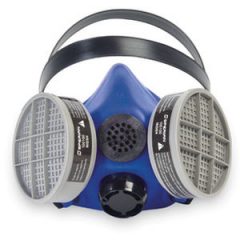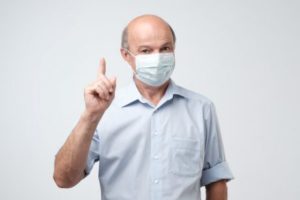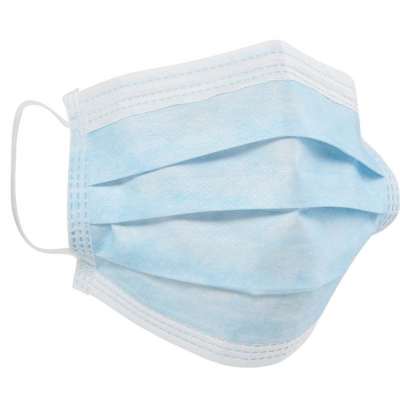How to choose a surgical mask or respirator?
Why choose a surgical mask?
Why choose a respirator?
Choosing a surgical mask or respirator
A mask can be either a disposable medical device (a “surgical” type mask) or personal protective equipment (a “respirator”), worn by caregivers and/or contagious patients. Depending on the type of mask, it protects against the transmission of infectious agents by “droplet” or “airborne” routes. Depending on the standard it meets and its protection class, it can prevent contamination by viruses such as coronavirus, SARS and H1N1.
How to choose a surgical mask or respirator?
Several criteria should be taken into account when choosing a mask such as application, type of mask, level of protection required, etc.
- Application: depending on the profession, the field of
 application and the presence or absence of contagious diseases, patients and caregivers use a certain type of mask with a certain level of protection.
application and the presence or absence of contagious diseases, patients and caregivers use a certain type of mask with a certain level of protection. - The type of mask: the two main types of masks are “surgical” masks and “respirators.” They have different functions, standards and objectives. The key point to keep in mind is that surgical masks only protect against infectious agents that can be transmitted via “droplets”, while protective masks or respirators also protect against the inhalation of infectious agents that can be transmitted by “airborne” routes.
- The level of protection required: each of these types of masks is subject to different standards and regulations in different countries. Within these standards, there are different classes of devices to determine the degree of protection. Refer to the regulations in your geographical area.
- Disposable or reusable: Surgical masks are only available as disposable. Respirators can be resuable. In the case of respirators, it is possible to replace the filter once it is full.
- Effective life: the duration of a mask’s effectiveness varies according to use. It can be between three and eight hours. A cheaper mask can mean a short period of use. This is systematically indicated by the manufacturer.
- Comfort: there are different sizes of masks, adaptable to the morphology of the person who will be wearing it. Protective masks or respirators can also be equipped with an exhalation valve to improve user comfort. Some masks also cover the eyes if eye protection is required. These are called full face respirators or masks.
Why choose a surgical mask?
A medical or surgical mask is a disposable medical device. It protects against infectious agents transmitted by “droplets.” However, it does not protect against “airborne” infectious agents. It will therefore not prevent the wearer from being potentially contaminated by a virus.
A surgical mask does two things:
- Prevents droplets of saliva or secretions from the upper respiratory tract when the wearer exhales. If worn by the
 caregiver, the surgical mask protects the patient and his or her environment (air, surfaces, equipment, surgical site). If worn by a contagious patient, it prevents the patient from contaminating his or her surroundings and environment.
caregiver, the surgical mask protects the patient and his or her environment (air, surfaces, equipment, surgical site). If worn by a contagious patient, it prevents the patient from contaminating his or her surroundings and environment. - Protects the wearer from infection transmitted by “droplets” or from the risk of splashs of biological fluids. In the latter case, the surgical mask must have a waterproof layer. It can also be equipped with a visor to protect the eyes.
“Surgical” masks can be used in different fields:
- Surgery
- Dentistry
- Other medical procedures
- In the case of isolation
Why choose a respirator?
A respirator is a type of personal protective equipment. It prevents the wearer from inhaling aerosols (dust, smoke, mist) as well as vapors or  gases (disinfectants, anesthetic gases) that are health hazards. It also protects the wearer from airborne infectious agents i.e. against contamination by a virus such as coronavirus, SARS, H1N1, etc.
gases (disinfectants, anesthetic gases) that are health hazards. It also protects the wearer from airborne infectious agents i.e. against contamination by a virus such as coronavirus, SARS, H1N1, etc.
Respirators are divided into two categories: insulating (which are not covered in this buying guide) and filtering.
Filtering respirators consist of a facepiece and a filtering device. Sometimes the filter element is integrated into the facepiece. Depending on the type of filter, the mask will either be effective only against particles, only against certain gases and vapors, or against particles, gases and vapors.
Filtering respirators can sometimes also be equipped with an exhalation valve to improve user comfort. The valve prevents condensation inside the mask, misting on the glasses and helps the user breathe in and out easily.
It should be noted that respirators also protect those who wear them from inhaling “droplets” of infectious agents.
Which surgical masks or respirators protect against contagious diseases and viruses?
In the presence of patients with contagious diseases or dangerous  viruses, caregivers must be equipped with a suitable type of mask with a sufficient level of protection. Let’s take the cases of tuberculosis, coronavirus, SARS, H1N1 and the risks of bioterrorism.
viruses, caregivers must be equipped with a suitable type of mask with a sufficient level of protection. Let’s take the cases of tuberculosis, coronavirus, SARS, H1N1 and the risks of bioterrorism.
- Tuberculosis:
For the contagious patient: it is necessary to wear a surgical mask to avoid contamination of the surroundings by the projection of saliva droplets or secretions from the upper respiratory tract during exhalation.
For caregivers and visitors: it is necessary to wear a protective mask of a class of at least FFP1 or FFP2 (Class N or R in the United States) in case of multi-resistant tuberculosis or particularly high-risk situations (intubation, induced sputum, etc.). - Coronavirus, SARS, H1N1:
For the contagious patient: it is necessary to wear the surgical mask as soon as contagion is suspected.
For caregivers: it is necessary to wear a protective mask of at least class FFP2 or FFP3 (Class N, R or P in the United States) for maximum filtration of particles and aerosols when caring for a patient who is infected or suspected of being so. - Anthrax type bioterrorism: it is necessary to wear a FFP2 or FFP3 respirator (Class N, R or P in the United States).
Should a disposable or reusable mask be used?
The surgical mask is a disposable medical device that must be disposed  of in the appropriate manner after use. Respirators can be disposable or reusable. In the second case, it is possible to replace the filter when it is full.
of in the appropriate manner after use. Respirators can be disposable or reusable. In the second case, it is possible to replace the filter when it is full.
The effective life of a surgical mask or a respirator is indicated by the manufacturer. It varies according to use. Generally speaking, it can range from three to eight hours depending on the concentration of the contaminant and a series of external factors such as air humidity, temperature, volume of air breathed in, etc.
For respirators equipped with gas filters, if the wearer begins to perceive the smell of gas, he or she must immediately leave the work area and replace the filter. Similarly in the case of dust filters, if the wearer begins to perceive an increase in inspiratory effort, he or she should leave the premises and replace the filter. These masks are mainly worn by people working in contact with chemicals or by firefighters.
How to use a mask?
Certain precautions should be taken when fitting a surgical mask or  respirator. These are the main ones:
respirator. These are the main ones:
- Remove the mask from the packaging and apply it to the face by holding it only by the ties.
- Make sure you put it on right side out with the strip up at the nose. In general, the information printed on the mask by the manufacturer should be displayed on the outside. If there is no specific indication, the most padded side should be applied to the face.
- Position the upper ties on the top of the head and the lower ties at neck level. The mask must be properly unfolded.
- The mask should cover the nose, mouth and chin. In the case of respirators, it is possible to check that the mask fits properly by closing the filter surface with your hands and inhaling slowly. If the mask tends to crush against the face it is well placed, otherwise it is incorrectly placed and leaks.
Once the mask is in place, it should not be touched or repositioned (except during removal). - If the mask is single-use, once the mask has been removed it should be disposed of immediately in the appropriate manner.
- The mask should be changed regularly: at least every three hours for a surgical mask (or before if it has been soiled by splashes) and between three and eight hours for a respirator.
- You should wash your hands before and after each mask change.

